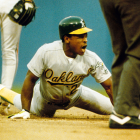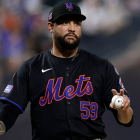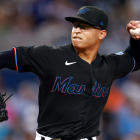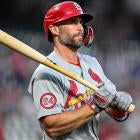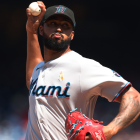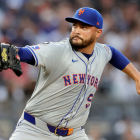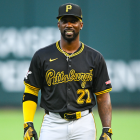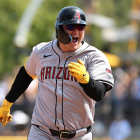One sunny Los Angeles afternoon way back in 2009, Dave Dameshek approached me with an idea. What if, the great broadcaster/writer/jack-of-all-trades said, we started a fantasy league? And not just any fantasy league. The League of Leagues.
Here’s the premise, Dave explained between slugs of ale. We take a fantasy baseball league, fantasy football league, and fantasy basketball league, and roll it all into one. Trade LeBron James for Tom Brady. Trade Aaron Rodgers for Albert Pujols. The wilder the deal, the better.
It took six years, but the League of Leagues finally came to fruition. Convening in the spring of 2015, 17 of us drafted 14 teams (three of us had partners) over two days, needing 12 and a half hours to draft full baseball, football, and basketball rosters.
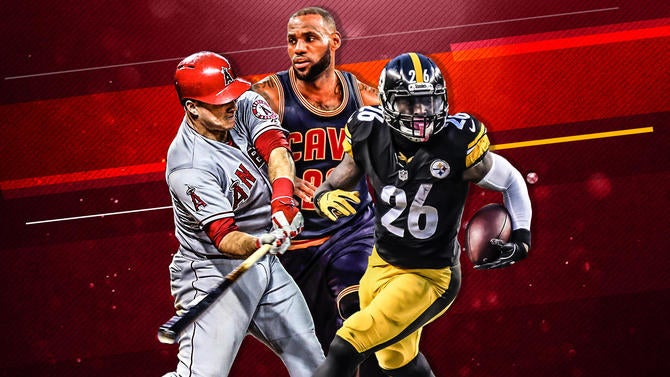
The original scoring system
- Regular roto rules apply for baseball and basketball:
(5x5 in baseball, except with OBP instead of AVG, and the standard eight categories for hoops)
- Regular head-to-head format in football
- Win any individual sport and you get 14 points
- Finish last and you get one point.
The overall winner is the team that compiles the most points over a span of one year, covering one season for each of the three sports.
The results
The results were surreal. Draft weekend felt like every scene from “The Matrix,” where each of us tried to turn endless lines of coded numerical gibberish into logic. “It’s the 27th round and I already have my two starting running backs and most of my outfield, time to draft that sleeper shooting guard” -- way-out thoughts like those.
Once the draft was done, trading immediately became fast, furious, and unbelievably nerdy and obscure. Let the record show that the first trade in League of Leagues history sent forgettable reliever Chad Qualls to a saves-speculating squad in exchange for Arizona Cardinals No. 3 wide receiver John Brown. Being the maniac that I am, it was of course I who proposed and ultimately made that deal. I’d go on to lead the League of Leagues by a country mile in frequency of trades, including three separate deals involving the very mediocre but somehow highly coveted John Brown.
In the end, the team of Sal Iacono (“The Jimmy Kimmel Show”) and Brian Gewirtz (long-time head writer for WWE Monday Night Raw) upset a wide array of fantasy and sport-specific experts, taking home the big prize. (The current basketball season still has a few days left, but the Iacono/Gewirtz team were dominant enough to have ostensibly clinched weeks ago.)
Last weekend in Las Vegas, we did it all over again. A few rule changes kicked in: Instead of two-year cycles, we would trim to one year, so that one single circuit of MLB, NFL, and NBA would crown a champion. We would add keepers, six total per team coming from any sports. We trimmed a few rounds by shortening the size of benches. We also tweaked our supplemental draft, providing greater incentives for teams to get aggressive in targeting incoming NFL and NBA rookies. Oh, and we also hoped to avoid getting skunked again by a guy who writes jokes for a late-night show, and his drafting partner who writes jokes for The Rock.
The draft
Once again, the draft was a corker. The first round went NBA-heavy, with owners realizing that basketball players are more predictable and less susceptible than football players, but also more valuable than baseball players due to rosters half the size. The top four picks overall (Russell Westbrook, James Harden, Giannis Antetokounmpo, and Anthony Davis) and seven of the top eight (Karl-Anthony Towns, Kevin Durant, and Stephen Curry went 6-7-8) were all NBA guys. After that, things predictably got nuts ... especially for League of Leagues first-timers experiencing the madness anew.
“That was the most exhilarating fantasy draft -- it was more of a tornado of choices and stress and excitement than I’ve ever participated in,” said CBS senior writer Bill Reiter, one of three CBS writers in the draft (myself and Will Brinson were the others). “Brilliant idea. Love it. Went with a very weird strategy that we have no sense of in terms of success or failure: Stock up on a great baseball team, put together a very middle-of-the-road basketball team with upside potential (Gordon Hayward, Paul George, Andre Drummond) and a few locked-in categories in which we can be competitive in (FG%, Blocks, Rebounds) and have a brutally bad football team that cobbled together might be so bad it’s good.”
The league features some heavy hitters as owners, including Rob Silver, the defending NFBC champion who last season took home the $125,000 grand prize. Shortening this year’s draft to a little less than 11 hours offered cold comfort to League of Leagues newbies like Silver, who had to contend with both an entire day of drafting, and the mental demands of seemingly infinite choices on every pick, given the three sports and many, many positions in play.
“If a regular three- or four-hour baseball draft is a marathon, an 11-hour, three-sport draft is like those crazy guys who run back-to-back marathons,” Silver said. “I never understood why anyone would do that to themselves. Just staying focused for that long isn’t easy.”
The strategy
On strategy, Silver said: “It’s a constant game of Whac-A-Mole if you aren’t punting any of the sports. Whatever sport you pick from, you are falling behind in two others at all times. I’m not sure if that’s an argument to punt a sport but it’s (by definition) a dynamic that’s not there in any other single-sport draft, which changes the strategy entirely compared to other drafts. The LoL is the proverbial three-dimensional chess compared to any other draft. I haven’t a clue how the season will play out.”
Post-draft uncertainty -- even self-loathing -- was a common theme. Instead of coming out of a typical fantasy baseball or football draft having a firm grasp of the quality of your roster compared to others, here you’re weighing three different rosters against 13 different owners. Down the road you’ll have to contend with hidden factors such as baseball players having depreciating trade value from day one since baseball is the first of the three sports being contested. Should you feel good about taking a top closer like Craig Kimbrel as low as the 14th round? Or do you second-guess yourself when the very next pick is an NBA All-Star like LaMarcus Aldridge, going off the board 195th overall?
“I only hate one of my three teams, post-draft,” quipped Jack Kogod, who’s written for multiple prominent sports blogs, included the late Kissing Suzy Kolber. “A few well-timed inter-sport trades and I’m pretty sure I’ll hate two, or possibly even all three. It really is the ideal fantasy setup.”
“The hardest part, by far, was trying to determine where certain runs would happen and how to value certain positions,” said Brinson, who is running his team with one of his friends as a co-owner. “With both our picks of Madison Bumgarner and Tom Brady, the timing felt right but then you see how the draft board falls and maybe we could have waited a round or two. There’s just an entirely different level of dynamic evaluation that takes place when you’re trying to evaluate the depth at multiple positions across multiple sports while also ensuring you’ve got enough talent in all three sports and doing it all in real time.”
By the time we wrapped up at close to 9 p.m. Vegas time (we started at 10 a.m.), brains were fried, and the ludicrous obscurity of some of the late-round picks was making us all loopy.
“It was great fun, but I have to confess -- the draft began to drag around the 396th round when Jonah started picking Canadian tee-ball players as potential keepers,” said Iacono, who was only half-kidding.
The next step will surely be a rush of trades -- glorious, mind-bendingly weird trades. NFL.com writer Adam Rank was gloating about the 12 touchdowns running back Rex Burkhead would score this year for the Patriots, a sure sign he’s already trying to pump up his trade value ... especially for football novices like me.
My own strategy was simple as I could possibly make it. It’s the same strategy I’d advise if you’re drafting your plain old baseball-only league this weekend: The IDGAC Plan, as in, I Don’t Give A Crap. Going on the theory that targeting certain players will result in heartbreak and confusion if you don’t get them, and embracing the idea that whatever you don’t get at the draft you can get via trades or free agency, I just take the guy who feels right in a given round, based on a cursory check of projection systems and experts’ predictions.
That meant taking David Johnson 10th overall, because if everyone’s going to take basketball players, at a certain point I should probably try something else. It meant grabbing Kyrie Irving as my second NBA player, despite his skill set being nearly identical to that of my first NBA player, Isaiah Thomas. And it meant diving back in for a second straight year on Jeanmar Gomez, because you can’t hold grudges against a closer if he’s sitting on the board in the 29th round and the pickings are getting slim in every sport.
By now you’re hopefully saying, “This sounds great! I definitely want to alienate my friends and family and play in a fantasy league that’s 10,000 times nerdier than the one I’m in now!” Well, you’re in luck, friend. Thanks to our awesome Webmaster/co-commissioner Toby Mergler, you can check out the League of League rules, draft results, and rosters, to see how it all works.
As Silver’s co-owner, Rotowire and Baseball HQ writer Vlad Sedler put it: “It’s definitely the most brain-stretching experience one could have at a draft. The term ‘strategery’ was created for just this type of event.”
That, and unlimited fun for fantasy players.









